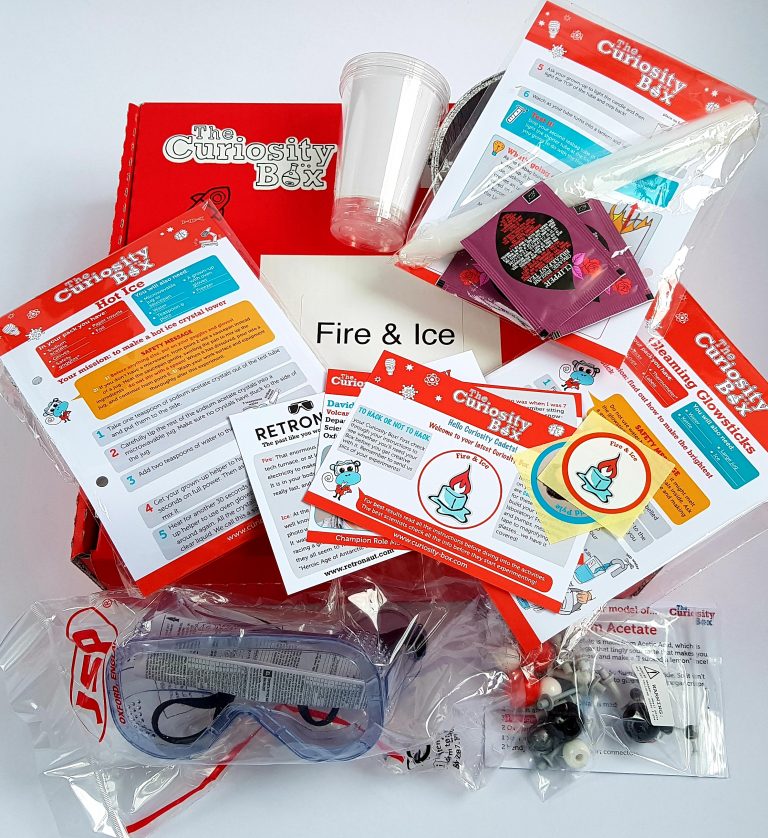The Curiosity Box is a science subscription box that send you monthly boxes of themed science experiments for the whole family to enjoy. It costs from £16.95 per month plus p+p. Along with the experiments, you also build up a collection of science equipment to keep and use again.
Quick note: Usually my reviews of kids’ and family things show the process with me and my daughter, Little C. For various reasons we’ve not actually been able to do these experiments together yet. However I’ll show you everything in the box, and give my opinion as to how good it looks. Having done quite bit of stuff like this I think I can make a reasonable assessment!
This theme is Fire and Ice.

The box is really rather big, it’ll mean a trip to the sorting office if you’re not in when the mailman arrives.
There are three cards in the box.

There is a featured scientist, plus some information relating to this month’s theme.

This is excellent advice! I don’t know about you, but I usually have to make sure my daughter stops and reads everything first before diving in.
Each experiment comes neatly bagged with its instructions and equipment.
Little Lanterns.

This is definitely a Fire experiment. You use teabags to make tiny little lanterns to see what happens when air warms up. This is definitely one for plenty of adult supervision, as it involves lighting things on fire! it’s especially thoughtful that the included teabags are paper (see the info on the card above.) It’s also one to do in the garden, and certainly be mindful of anything flammable close by!

Gleaming Glowsticks. Every child every loves glowsticks, so I’m sure this will be a big hit!

This uses water to test the effect of varying temperatures on the glowsticks. Like I said, glowsticks are familiar to every child, and it will be useful to see how to maximize their power!
One thing: there is a thermometer included. It’s a proper one, made of glass (though fortunately no mercury like I remember from my childhood!) My problem is that glass is breakable. That wouldn’t be so bad in itself, it’s not going to break on its own. However the protective tube it came in (which is a good idea) is slightly too small for the thermometer, and the stopper doesn’t fit on properly. When I was unpacking everything to photograph, the thermometer fell right out of the tube onto the floor, as I didn’t realise it wasn’t properly sealed. Fortunately it fell about a foot onto paper over a wood floor, so no harm done. But we do this stuff in our kitchen, which has a hard tile floor. I know these things are hard to break, but even so. It would have been better to have a tube that sealed up properly, or at least have the stopper taped on.

Hot Ice. Even the name is curious!

This looks absolutely brilliant. It’s all about supersaturated solutions, and you get to make a crystal tower! While this one might require some dexterity, it’s going to be seriously impressive.
There are two bonus items this month too:

Real goggles! Not toy ones, but proper grownup scientist goggles. Little C has always wanted a pair of these!

This is a cool model of a Sodium Acetate molecule to put together. This gives a great tactile view of something that you can’t actually see, plus sodium acetate is used in the Hot Ice experiment.
I really want to do these experiments myself, especially the Hot Ice, but as Little C (my daughter) is very keen on science, I should probably wait until she’s able to at least help out.
The instructions are nice and clear, though there is definitely adult assistance required.
This box, especially the Hot Ice, definitely has a ‘proper science’ feel about it. I know it’s all science-related, but making crystals is guaranteed to be exciting!
The cards contain excellent extra information relating to the experiment subject. Each card is also punched, so you can stick them in a ringbinder folder to keep. I also think it’s fantastic to include things that can be used repeatedly. The goggles are brilliant, a great way to make a child feel like a ‘proper’ scientist, and the molecule model is fascinating. I did have a quibble with the thermomenter problem, but oddly enough a digital thermometer was included with the ‘Space’ box, so that could also be used if you’ve got it. You could even just use a regular kitchen thermometer!
The value, at less than £20 per month (less if you pick a longer subscription) is pretty good. It’s not cheap, but the experiments will take a reasonable amount of time to complete, and the equipment, instructions, and educational value are excellent.
While I’ve not actually tested these experiments yet I’m sure they will do exactly what they’re supposed to do!











